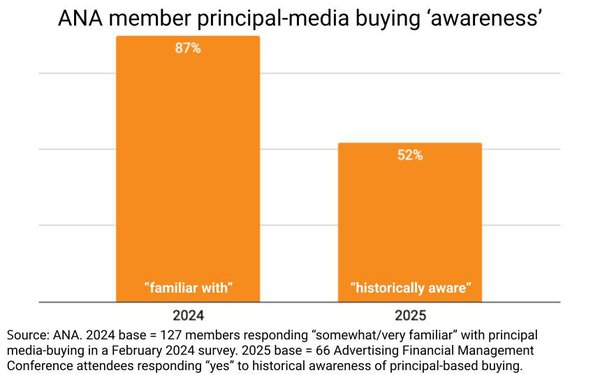
Full disclosure -- the chart shown above
represents some apples-to-oranges comparisons, but I combined them to illustrate a bigger, more overarching problem for the advertising and media-buying industry: that 40 years after the classic 15%
commission began fading away, a significant share of the world's biggest advertisers don't fully understand how the modern day principal-based media-buying model evolved, and more specifically, how it
actually works.
In other words, there is a profound need to educate marketers about the practice overall, as well as drill down into the differences between agent- and principal-base
media-buying models.
Coincidentally, those are the two top takeaways from yet another new study published by the Association of National Advertisers this week, and it demonstrates just how
confusing the modern client/agency media services relationship can be.
advertisement
advertisement
To be clear, there are a multitude of other factors -- both above and below the line -- that contribute to the confusion,
including the evolution of programmatic media-buying, rebates, kickbacks, media neutrality, the role of big digital advertising platforms, etc., that make even the smartest marketers' (as well as some
trade press journalists') heads hurt.
But sticking with the binary focus of agent vs. principal buying focus of the new ANA report, which ostensibly should be simpler to understand... well,
it's not.
I mean, just consider that 8% of the ANA members responding to a survey at the ANA's recent Advertising Financial Management Conference don't understand the difference between
principal media-buying and "corporate trade" and "barter" media-buying models.
Actually, that should not be surprising, because while they are two different things -- in principle -- a barter
agency could be working as an agent or a principal media-buyer in those cases, too. But that's a conversation for another ANA member survey to be conducted in the future.

The bottom line is advertisers don't just have an
awareness problem when it comes to principal media-buying, they don't understand the history of how and why it evolved, and what the nuances and implications of it are.
You can read the new
study in depth here, but to me the biggest takeaway actually is the law of unintended consequences when
industrial norms begin to shift because of changes in underlying business models, and the biggest concern advertisers should have is one of the oldest concerns in advertising and media-buying: media
neutrality.
That was an issue when agencies made big, fat margins from the 15% commission on full-service accounts, and it's an issue now that they have to scrap for profits in a multitude of
niche service models, some of which can be out-of-house, in-house or co-housed.
But at least in the old days you knew who your agent was and who he or she was actually working for.